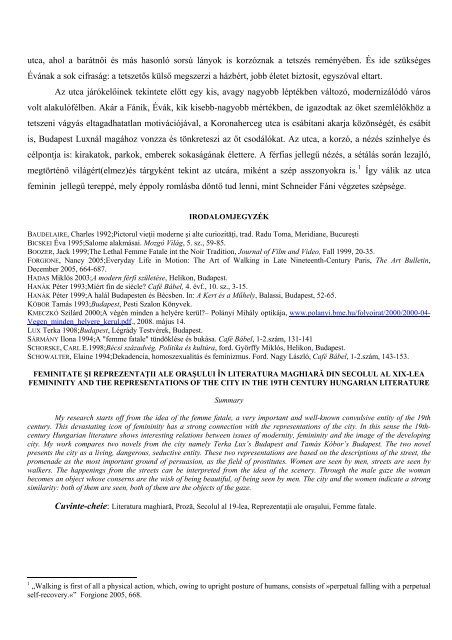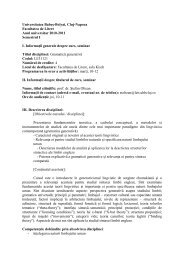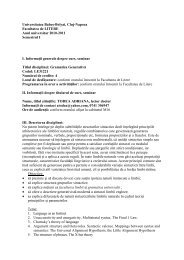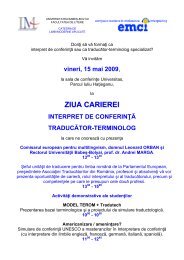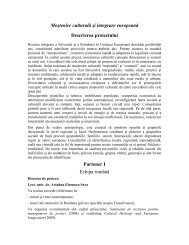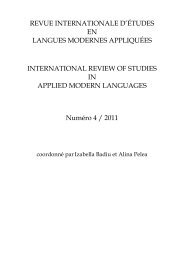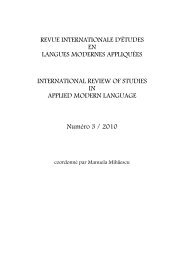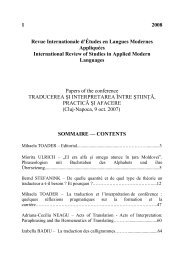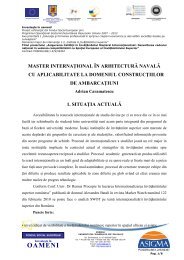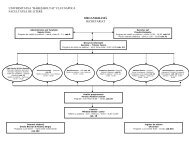Dimensiuni ale limbajului n context carceral
Dimensiuni ale limbajului n context carceral
Dimensiuni ale limbajului n context carceral
You also want an ePaper? Increase the reach of your titles
YUMPU automatically turns print PDFs into web optimized ePapers that Google loves.
utca, ahol a barátnői és más hasonló sorsú lányok is korzóznak a tetszés reményében. És ide szükséges<br />
Évának a sok cifraság: a tetszetős külső megszerzi a házbért, jobb életet biztosít, egyszóval eltart.<br />
Az utca járókelőinek tekintete előtt egy kis, avagy nagyobb léptékben változó, modernizálódó város<br />
volt alakulófélben. Akár a Fánik, Évák, kik kisebb-nagyobb mértékben, de igazodtak az őket szemlélőkhöz a<br />
tetszeni vágyás eltagadhatatlan motivációjával, a Koronaherceg utca is csábítani akarja közönségét, és csábít<br />
is, Budapest Luxnál magához vonzza és tönkreteszi az őt csodálókat. Az utca, a korzó, a nézés színhelye és<br />
célpontja is: kirakatok, parkok, emberek sokaságának élettere. A férfias jellegű nézés, a sétálás során lezajló,<br />
megtörténő világért(elmez)és tárgyként tekint az utcára, miként a szép asszonyokra is. 1 Így válik az utca<br />
feminin jellegű tereppé, mely éppoly romlásba döntő tud lenni, mint Schneider Fáni végzetes szépsége.<br />
IRODALOMJEGYZÉK<br />
BAUDELAIRE, Charles 1992;Pictorul vieţii moderne şi alte curiozităţi, trad. Radu Toma, Meridiane, Bucureşti<br />
BICSKEI Éva 1995;Salome alakmásai. Mozgó Világ, 5. sz., 59-85.<br />
BOOZER, Jack 1999;The Lethal Femme Fat<strong>ale</strong> int the Noir Tradition, Journal of Film and Video, Fall 1999, 20-35.<br />
FORGIONE, Nancy 2005;Everyday Life in Motion: The Art of Walking in Late Nineteenth-Century Paris, The Art Bulletin,<br />
December 2005, 664-687.<br />
HADAS Miklós 2003;A modern férfi születése, Helikon, Budapest.<br />
HANÁK Péter 1993;Miért fin de siècle? Café Bábel, 4. évf., 10. sz., 3-15.<br />
HANÁK Péter 1999;A halál Budapesten és Bécsben. In: A Kert és a Műhely, Balassi, Budapest, 52-65.<br />
KÓBOR Tamás 1993;Budapest, Pesti Szalon Könyvek.<br />
KMECZKÓ Szilárd 2000;A végén minden a helyére kerül?– Polányi Mihály optikája, www.polanyi.bme.hu/folyoirat/2000/2000-04-<br />
Vegen_minden_helyere_kerul.pdf., 2008. május 14.<br />
LUX Terka 1908;Budapest, Légrády Testvérek, Budapest.<br />
SÁRMÁNY Ilona 1994;A "femme fat<strong>ale</strong>" tündöklése és bukása. Café Bábel, 1-2.szám, 131-141<br />
SCHORSKE, CARL E.1998;Bécsi századvég. Politika és kultúra, ford. Györffy Miklós, Helikon, Budapest.<br />
SCHOWALTER, Elaine 1994;Dekadencia, homoszexualitás és feminizmus. Ford. Nagy László, Café Bábel, 1-2.szám, 143-153.<br />
FEMINITATE ŞI REPREZENTAŢII ALE ORAŞULUI ÎN LITERATURA MAGHIARĂ DIN SECOLUL AL XIX-LEA<br />
FEMININITY AND THE REPRESENTATIONS OF THE CITY IN THE 19TH CENTURY HUNGARIAN LITERATURE<br />
Summary<br />
My research starts off from the idea of the femme fat<strong>ale</strong>, a very important and well-known convulsive entity of the 19th<br />
century. This devastating icon of femininity has a strong connection with the representations of the city. In this sense the 19thcentury<br />
Hungarian literature shows interesting relations between issues of modernity, femininity and the image of the developing<br />
city. My work compares two novels from the city namely Terka Lux’s Budapest and Tamás Kóbor’s Budapest. The two novel<br />
presents the city as a living, dangerous, seductive entity. These two representations are based on the descriptions of the street, the<br />
promenade as the most important ground of persuasion, as the field of prostitutes. Women are seen by men, streets are seen by<br />
walkers. The happenings from the streets can be interpreted from the idea of the scenery. Through the m<strong>ale</strong> gaze the woman<br />
becomes an object whose conserns are the wish of being beautiful, of being seen by men. The city and the women indicate a strong<br />
similarity: both of them are seen, both of them are the objects of the gaze.<br />
Cuvinte-cheie: Literatura maghiară, Proză, Secolul al 19-lea, Reprezentaţii <strong>ale</strong> oraşului, Femme fat<strong>ale</strong>.<br />
1<br />
„Walking is first of all a physical action, which, owing to upright posture of humans, consists of »perpetual falling with a perpetual<br />
self-recovery.«” Forgione 2005, 668.


